 Image search results - "hi" Image search results - "hi" |

Three-day (Aug. 9-11, 2006) rowing route around the southern half of the lake by the Kyoto Univ. rowing club.1st day: Home base in Seta River to Manohama (crew change), then to Omi-Maiko.
2nd day: Omi-Maiko to Manohama, then to Chomeiji.
3rd day: Chomeiji to Manohama where crew changes. Then to home base in Seta River.
|
|

Sadly, the Tokyo Jidai Matsuri no longer held. It used to be held annually on Nov. 3 (Culture Day) in Asakusa, Tokyo.the Tokyo Jidai Matsuri (Festival of Historical Periods) is a parade tracing the history of Tokyo with over 1,600 people dressed in the respective period's costume. This is the lead float playing music. It took about an hour for the parade to reach Kaminarimon Gate.
Lead Float: Edo festival music played by children. Kodomo Edo-bayashi yatai
先導 子供江戸囃子屋台
|
|

Held during late April to early May, Kanna's Koinobori festival of carp streamers is this town's claim to fame. About 800 colorful carp streamers swim in the sky above a river. Strings of carp streamers viewable from the road.
|
|

Ehime Maru Memorial in Kakaako Waterfront Park, Honolulu えひめ丸慰霊之碑The memorial is on a slope with a good view of the ocean. It was indeed a suitable place for such a memorial.
|
|

Also called "Sennin Gyoretsu" (1,000-person Procession 千人行列), this is Nikko's largest festival held on May 17-18. The highlight is a long procession of over 1,000 people dressed in various costumes.The three portable shrines are dedicated to the spirits of Tokugawa Ieyasu, Toyotomi Hideyoshi, and Minamoto Yoritomo. Photos start with May 17 at Toshogu Shrine, when priests gathered for a ceremony. 発興祭
|
|

Matsuyama Castle
|
|

Fukuyama Castle tower
|
|

Sign for Tomonoura. Tomonoura is a National Important Traditional Townscape Preservation District (重要伝統的建造物群保存地区).
|
|

Takeshima island is connected by a bridge. The island is uninhabited, but has a Yaotomi Jinja Shinto shrine (八百富神社) dedicated to goddess Takeshima Benten. Designated as a Natural Monument for its flora which greatly differs from that on shore.
|
|

Sign for boat going to the islands (no longer in service)
|
|

Okazaki Castle towerThe castle was dismantled during the Meiji Period and the area was made into a castle park. The castle tower was later rebuilt in 1959.
|
|

One of Japan's grandest festivals, the Tokushima Awa Odori is a summer dance performed in central Tokushima city. Numerous dance troupes called "ren" appear in a long parade along the city's main streets for four evenings in mid-Aug. About 2 million people see it during the four days it is held. It is like a bon dance to greet the souls of the deceased returning to visit. There are other Awa Odori festivals in Japan, but the one in Tokushima is the original and largest one. "Awa" is the former feudal name of Tokushima. Photo: Entrance to one of the spectator areas called "embujo" (admission charged). 藍場浜演舞場
|
|

Yamauchi Kazutoyo's castle. My Contax compact film camera had a bad lens day, making the images foggy.
|
|

Uwajima Station
|
|

Uwajima Castle tower (Important Cultural Property), Ehime Prefecture.
|
|

Imabari Station
|
|
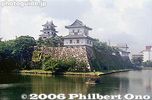
Originally built in 1604 by Lord Takatora Todo, Imabari Castle today is still a very good castle complex with great views of the city and Inland Sea. The castle tower was reconstructed in 1980. 今治城Unfortunately, my camera lens had a fogging problem.
|
|

Occupying a huge plot of land in the center of the city, Kanazawa Castle has undergone extensive renovations and reconstruction. The main castle buildings are now magnificently restored.
|
|

Kenrokuen is one of Japan's three most famous gardens (besides Korakuen in Okayama and Kairakuen in Mito, Ibaraki). The garden was originally the castle garden for Kanazawa Castle. Katsurazaka Entrance to Kenrokuen Garden 桂坂口
|
|

Tobu Line train to Nikko. It takes about 2 hours from Asakusa, Tokyo.
|
|

JR Chiba Station and Yokosuka Line
|
|

Map of Kanazawa Castle Park and Kenrokuen Garden
|
|

Established in 1617, Tsukiji Hongwanji temple is the Tokyo headquarters of the Nishi Hongwanji Jodo Shinshu sect. The present temple, based on Indian architecture, was built in the 1930s.The temple is the only one in Japan which is under the direct control of the sect. Its head priest is the Monshu Abbot himself. April 8 is observed as Buddha's birthday, called Hana Matsuri ("Flower Festival) in Japan.
|
|

Yasukuni Shrine is Japan's most prominent shrine for the war dead. Near Kudanshita Station on the Tozai Subway Line. This is the first giant torii
|
|

The Kusatsu Shukuba Matsuri Festival is held on April 29 to celebrate Kusatsu's history as a post town on the Nakasendo and Tokaido Roads. Numerous events and activities are held such as flea markets, street & stage performances, and Japanese danThis was the first time I saw hula dancing in Shiga. Surprised to see hula dancing (Kusatsu Station plaza).
|
|

Very little remains of Otowa castle originally built by Lord Gamou Sadahide. Two battles took place here in 1496 and 1503. Road to Otowa Castle on the hill seen on the left.
|
|

Hino was home to many Omi merchants who plied up and down Japan during the Edo Period to sell and trade their wares. They became quite successful selling medicines, lacquerware, sake, etc. Those from Hino were called Hino shonin (Hino merchants).
|
|

Hino's most prominent shrine is best known for the Hino Matsuri festival on May 2-3. The shrine was originally atop Mt. Watamuki, Hino's tallest mountain. It was moved to its present location in 796.
|
|

Nakano Castle, also known as Hino Castle, built in 1534 by Lord Gamou Sadahide (1508-1579). In 1582, when Oda Nobunaga was assassinated in Kyoto, Lord Gamo Katahide brought Nobunaga's wife and children from Azuchi Castle to Hino Castle for their safe
|
|

Held annually on May 4, the Misaki Shrine Fire Festival (hi-matsuri) has local people carry 2-meter long torches from their homes to the shrie where a 5-meter tall pile of bamboo is lit to make a towering inferno.A taiko drum is also carried and beaten.
|
|

Held on Dec. 2-3 by Chichibu Shrine, Chichibu Yomatsuri is one of Japan's Big Three Hikiyama Float Festivals. Ornate floats are pulled along the city's main streets until they reach a large plaza at night where they are lit with lanterns. Fireworks then serve as the climax. Photo: Seibu Chichibu Station
|
|

Azuchi Nobunaga Matsuri used to be held on the first Sunday in June, but it's now held in Nov. (since 2020). The festival is dedicated to Oda Nobunaga who built Azuchi Castle. Parking available at nearby Bungei no Sato.
|
|

Kakegawa Castle as seen from the train
|
|

Kakegawa Station, south entrance
|
|

Yasukuni Shrine during the Mitama Matsuri before dark.
|
|

Road to Himeji Castle. From Himeji Station, the main road leads to the castle which can be seen in the distance.
|
|

Akashi StationOn the JR Sanyo Line.
|
|

Akashi Castle seen from the train platform of Akashi Station.
|
|

Inuyama Yuen Station. Closest station to Inuyama Castle on the Meitetsu Line.
|
|

Road to Inuyama Castle
|
|

Road marker. Established in 1642, Moriyama-juku was the sixty-seventh of the sixty-nine stations or shukuba post towns on the Nakasendo Road. It is the eighth Nakasendo station in Shiga (following Musa-juku in Omi-Hachiman).
|
|

Three boats are used for the trip, sighted here off shore near JR Hira Station on the Kosei Line. 湖西線比良駅の沖
|
|

Held for two evenings on Aug. 14-15 during the obon season, people light their torches at Gosha Shrine and proceed to Hibarino park where the torches are thrown up to a large pine tree. The more torches get stuck on the tree, the better the next harvest.This is Hibarino park. The pine tree on the right of the small hill is the target for the torches. This park also serves as the Otabisho during the Hino Festival.
|
|

Nose Myokenzan Betsuin at a street corner. In Feb., priests at this small temple splash cold water on themselves for 30 min. Near Honjo-Azumabashi Station on the Toei Asakusa Line or JR Kinshicho Station on the Sobu Line.
|
|

JR Tachikawa Station
|
|

Seta Rowing Club's 2-story clubhouse located in Otsu, Shiga Prefecture. The club is a registered NPO. The club is named after Seta River at the southern tip of Lake Biwa. Regattas are also held on the river, Lake Biwa's sole outflowing river.
|
|

Toriimoto-juku is the sixty-third of the sixty-nine stations or shukuba post towns on the Nakasendo Road. It is the fourth Nakasendo station in Shiga (following Bamba-juku in Maibara), and one of ten Nakasendo stations in Shiga.
|
|

At 2 pm, the 18 portable shrines gather at the Ohara Fishing Port. 大原漁港に参集
|
|

The outdoor architectural museum is within Koganei Park in Koganei, Tokyo. This is the Visitors Center.
|
|

Bird's eye view of Shirakawa-go from Ogimachi Castle ruins.
|
|

Side view of Wada-ke House
|
|

Ryogoku Kokugikan sumo arena as seen from Ryogoku Station
|
|

Monorail to Chiba Koen Station 千葉公園駅
|
|

Chiba Castle as seen from Kencho-mae monorail station.
|
|

Gate to Kitain, a Tendai Buddhist temple. Part of Kawagoe's National Important Traditional Townscape Preservation District (重要伝統的建造物群保存地区).
|
|

Moving the Neputa floats into position.Held during Aug. 1-7, the Hirosaki Neputa Matsuri is without the rowdiness of the Aomori Nebuta Matsuri. Instead of the haneto, there are many children pulling the floats with ropes. The main floats are fan-shaped and more two-dimensional and lantern-like. As with the Nebuta floats, the Neputa floats are handpainted and illuminated from the inside. There are two parade routes which are followed alternately on different nights. On the 7th, there is only a daytime parade from 10:00 a.m. If it rains on any day, the parade may be canceled.
|
|

PR poster designed by Tetsuo OshiroPoster for the race.
京都大学ボート部OBの尾城徹雄様に作成したポスター。大学内や大津市石山商店街などで張り出された。
|
|

Lake Biwa is near the center of Honshu island between Nagoya and Kyoto.
|
|

Held in July, Narita Gion Matsuri Festival has ornate floats pulled on the streets of Narita and to Narita-san temple. Pulling a float on the street
|
|

From late April to early May, five long strings of giant carp streamers swim in the air high above the Sagami River in Sagamihara, Kanagawa. This event was started in 1988.
|
|

Keisei Narita Station. Getting to Narita is cheaper via Keisei Railway.
|
|

The biggest taiko drum festival in the Kanto region is held annually in April. Various taiko drum troupes perform for two full days on various outdoor stages in Narita, including the main stage in front of the Narita-san temple.
|
|

"Hana no Kai" Dance by Kagurazaka geishaThe "Hana no Kai" geisha dance is held annually by geisha in Kagurazaka, one of Tokyo's major geisha districts. "Hana" means livley or gaudy. And "Kai" can mean gathering or party.
They held two shows on the same day. This was the second show starting at 3 pm on April 16, 2005. It lasted till about 4:45 pm.
|
|

JR Kofu Station
|
|

One of two giant kitesThis festival has two giant kites and two smaller (but still large) kites. Resting on its side, the kite was scheduled to fly at 2 pm. The kanji characters read "Michi no Eki" in reference to a new train station built in the town.
|
|

Festival's focal pointThis grass hut is at the center of the festival site which is within the Sakitama Tumuli Park. It will be burned later in the evening for the festival's climax.
|
|

This page is a complete English guide to all the groups that appear in the parade. The parade assembles behind Sensoji Temple and starts at 1:30 pm from Nitenmon gate. The procession then goes down Umamichi-dori street, passes by Matsuya Department Store.先導 子供江戸囃子屋台
|
|

Shirakawa-go is also a National Important Traditional Townscape Preservation District (重要伝統的建造物群保存地区).
|
|

Strings of carp streamers latched to the ground from the mountaintop.
|
|

The memorial was unveiled on Feb. 9, 2002, a year after the accident.
|
|

Prayer ceremony by priests
|
|

Entrance to castle tower
|
|

Fukuyama Castle tower
|
|

Ferry between Tomonoura and Sensui island.
|
|

400-meter long bridge to Takeshima island near JR Gamagori Station. The island is made of granite. Circumference is 680 meters. There's a walking path around the island.
|
|

Rabbit Island
|
|
|
|

The festival is held along a straight, 800-meter section of San'o Odori Road, a 20-min. walk from Akita Station.In the evening, the main event starts at 6:38 p.m. with a taiko drum-beating performance or minyo dancers on San'o Odori Road. At 7:17 p.m., some 200 kanto are carried into the street to the sound of flutes and taiko drums. At 7:40 p.m. following a brief address by the city's mayor, the performance begins as the kanto are raised all at once.
|
|

Spectator seats. Admission is 1,000 to 2,000 yen.
|
|

Near the castle gate
|
|

Fighting bull statue in front of Uwajima Station.
|
|

Castle tower
|
|

Imabari Station
|
|
|

Kanazawa Castle was the base for the Kaga Domain (Ishikawa and Toyama Prefectures) ruled by the Maeda clan 1583–1871 starting with Maeda Toshiie.
|
|

Entrance to Inohana Park
|
|

Inside Tobu Line train
|
|

Ninomaru Northern Stone wall along a moat. 二の丸北面石垣
|
|

Kenrokuen is classified as a "kaiyu-shiki teien" (回遊式庭園) or "circular-strolling Japanese garden." It's a common and classic Japanese garden design where you simply walk around the garden, usually around a central pond.
|
|

Tsukiji Hongwanji temple gate with wisteria crest.The emblem is a wisteria flower and symbol of the Jodo Shinshu sect.
|
|

Path to shrine
|
|
|

Barrels of Hino merchant sake
|
|

The castle is somewhat out of the way. It's a 15-min. walk from the nearest bus stop.
|
|

Later the shrine became Lord Gamou's family shrine and it was revered by Hino merchants during the Edo Period. This is the Shrine grounds. Map
|
|

The castle was abandoned in 1597. Only a few stone walls and shrines remain adjacent to Hinokawa Dam. This is one entrance to Nakano Castle. Map
|
|

Procession of local residents carrying torches to the shrine. Map
|
|

In front of Seibu Chichibu Station
|
|

Being my first regatta, I was at first daunted by the rowing terminology for the different types of boats.
|
|

Yasukuni Shrine's main torii during Mitama Matsuri
|
|

The Azuchi Nobunaga Festival's main venue was here, next to Azuchi Castle (hill on right). MAP
|
|

Kakegawa Station, north entrance
|
|

Yotsuashi-mon GateMain gate to enter the castle grounds. A reconstruction.
四足門
|
|

Road to Himeji Castle. Otemae Boulevard (Symbol Road). 大手前通り
|
|

Akashi Castle seen from the train platform of Akashi Station.
|
|

Kiso River with Inuyama Castle in the distance
|
|

Inuyama Cultural History Museum犬山市文化史料館
|
|

Road marker. Go right for the Nakasendo Road. MAP
|
|

Arriving Omi-Maiko on Day 1. Rowing around the lake has been an annual tradition.
|
|

Entrance to Gosha Shrine. 五社神社
|
|

Shrine hall
|
|

JR Tachikawa Station entrance
|
|
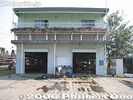
Seta Rowing Club's clubhouse. Boats are stored on the bottom floor, while the 2nd floor has office space, ergo machines, meeting room, locker room, etc. Web site here
|
|

Although the Honjin is long gone, there are a few reminders of its shukuba past. Near Ohmi Railways Toriimoto Station. Map
|
|

They run around while carrying a portable shrine.
|
|

Going to visitors center
|
|

Crowd outside the Kokugikan await their favorite wrestlers.
|
|

Path to Wada House entrance
|
|

JR Chiba Station platform
|
|

View of Chiba Park from monorail. 綿打池
|
|

Kitain Main hall, Kawagoe
|
|

There are three types of floats: the large fan-shaped Neputa, Nebuta-type figures, and the children's small Neputa.I got to Hirosaki early enough before the parade to see the floats lined up at the starting point. Hirosaki is a 30-min. train ride from Aomori, and best known for Hirosaki Castle during cherry blossom season.
|
|

The shrine also holds the Hino Matsuri on May 2-3.
|
|

Pulling the float, Narita Gion Matsuri
|
|

There are five rows of streamers. In Japan, the koi carp is regarded as a symbol of valiant manhood because it swims up the river against the rapids.
|
|
|

"Blue Ocean Waves" (青海波)They performed four numbers. This first one was called "Blue Ocean Waves" performed by five geisha.
|
|

Park in front of Kofu Station.
|
|
|
|

Keisei Narita StationThe Narita City Hall can be seen with the green, temple-like roof.
|
|

Offerings
|
|

From Matsuya Department Store, the procession turns right into Kaminarimon-dori street which passes in front of the famous, giant red lantern called Kaminarimon Gate. Lead float with Edo festival music played by children. 先導 子供江戸囃子屋台
|
|

Eight strings of carp streamers hover over the river.
|
|

Tobu Nikko Station 東武日光駅
|
|
|

In front of the portable shrine storehouse for the three mikoshi. A ceremony is held to transfer the spirits from the main shrine to the portable shrines. 神輿舎にて宵成渡御This building is right next to the famous Yomei-mon Gate at the Toshogu Shrine.
神輿舎にて宵成渡御
|
|
|
|

View from castle tower
|
|
|

Torii on Takeshima island
|
|
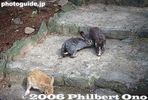
Rabbits
|
|

Bridge and azaleas
|
|

Tokushima Airport
|
|

Crowds already line Tokushima's main street soon to be closed to traffic.
|
|
|
|

Shopping arcade
|
|

Inside Uwajima Castle tower.
|
|
|

My bicycle
|
|
|

Path to Chiba Castle (visible on left)
|
|

Shinmaru Park 新丸広場
|
|

Kasumigaike Pond and the famous Kotoji-toro stone lantern. The lantern is shaped like a bridge that supports a string on the koto instrument. 霞ヶ池 徽軫灯籠
|
|

Temple gate and flag
|
|
|

The Kusatsu-juku Honjin is decorated with curtains. MAP
|
|

The castle met its demise in 1522 less than 60 years after it was built, after a war within the Gamou Clan. It now serves as a large hilltop park with good views of the surroundings. Otowa Castle marker
|
|

Manhole with the symbol of Hino merchant, Shiga Prefecture
|
|

Torii at Umamioka Watamuki Shrine in Hino, Shiga Pref.
|
|

Path to Nakano Castle ruins
|
|
|
|

Main street crowd
|
|

Carrying back a single sculling boat
|
|

Promenade to the shrine
|
|
|
|

Karahashi Bridge as the starting point for alumni races
|
|

Main street in front of station
|
|

Steps to the castle tower
|
|

Uchibori Inner Moat
|
|

Inuyama Castle
|
|

Karakuri Doll Museumからくり展示館
|
|

Rear of road marker
|
|
|
|

Barrels of cold water in front of shrine
|
|

Gosha Shrine torii
|
|

JR Tachikawa Station walkways
|
|

Oars and boats stored on the bottom floor. The club offers 2-hour rowing lessons on Sundays during May to Nov. Address: 6-1 Ogaya, Otsu, Shiga 520-2144 Japan. Phone/Fax: 077-545-9961, Email: info@setarc.jp
|
|

Ohmi Railways Toriimoto Station platform
|
|
|

Close-up of Ogimachi
|
|

Visitors Center entrance courtyard
|
|

Main house on left and latrine on right with large vats to gather fertilizer.
|
|

Crowd enters the Kokugikan for Musashimaru's retirement ceremony on Oct. 2, 2004.
|
|

JR Chiba Station
|
|

Chiba Park approach
|
|

Children lead the way for a float at Kawagoe Festival.
|
|

Main hall
|
|

Lunch break
|
|

Tired from walking, Narita Gion Matsuri
|
|

The cable length is 250 meters and 13mmm thick. There are about 1,200 carp streamers. They are reused every year and donated by local families. (I also noticed a few advertising carps.)
|
|

JR Narita Station
|
|
|

Notice that the kimono design shows waves.
|
|

Statue of Takeda Shingen.
|
|
|

Festival siteIt is a circular site with people sitting along the perimeter.
|
|

Lead float with Edo festival music played by children. The names of the children playing are written on the red lanterns hanging above. Kodomo Edo-bayashi yatai 先導 子供江戸囃子屋台
|
|
|

These pictures were taken in May 2003, when Kanna-machi town was newly formed upon the merging of Manba town and Nakazato village.
|
|

On Feb. 9, 2001, a small Japanese fisheries training boat from Uwajima, Ehime Prefecture was struck by the USS Greeneville submarine as it bolted to the surface off the coast of Honolulu, Hawaii. Nine Japanese high school students, teachers, and crewmen died aboard the Ehime Maru. A year later, a waterfront memorial was built in Honolulu.
|
|

Shinkyo Sacred Bridge, Nikko 神橋
|
|
|

View from top floor
|
|
|

My bicycle somewhere in Gamagori.
|
|

Feeding a rabbit
|
|

Azaleas
|
|

Tokushima Station
|
|

These photos were taken in Aug. 1999.
|
|
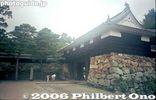
Castle gate
|
|

Inside castle tower
|
|
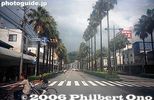
Main road in Uwajima
|
|

City Hall
|
|
|
|

Chiba Castle and paper lanterns
|
|

Dobashi-mon Gate stone walls 土橋門石垣
|
|

Famous Kotoji-toro stone lantern 徽軫灯籠
|
|

Play room for kids on Hanamatsuri
|
|

Statue of Omura Masujiro (1824-1869) 大村益次郎, founder of Japan's modern army. Also pushed for the establishment of Yasukuni Shrine.
|
|

Shukuba Odori dance in the shopping arcade.Held 11:00 - 12:00
|
|

Suzuka Quasi-National Park markerThe area is within this park.
|
|

Omi Hino Merchant House. The former home of Hino merchant Yamanaka Hyouemon was donated to the town in 1981. Now a museum exhibiting the history and artifacts of the Hino merchants. 近江日野商人館Small admission charged. Open 9 am to 4 pm, closed on Mon. and Fri. Close to the center of town.
Address: Okubo 1011, Hino-cho
Phone No.: 0748-52-0007
山中兵右衛門
|
|

Stone bridge
|
|
|
|

The torch procession rings out.
|
|

Fukuyama Castle from the train
|
|

Floats parked along the main drag.
|
|

The place was not as crowded as you would think.
|
|

Stage entertainment (Azuchi Castle ruins in background).
|
|

Kakegawa, Shizuoka
|
|

Castle tower
|
|

Castle moat
|
|

Spotlights create a silhouette of the statue of Omura Masujiro (1824-1869) 大村益次郎, founder of Japan's modern army.
|
|

Castle moat
|
|

Inuyama Castle
|
|

Karakuri Doll MuseumThe karakuri dolls, set atop ornate floats, are controlled with strings.
|
|

Marker for the Kabuto-ya inn
|
|

They use four-man boats (called "knuckle four" in Japanese) with sliding seats. It is stable and safe, ideal for beginners.
|
|
|

Barrels of cold water
|
|

Walkway sculpture
|
|

Many boats are made in Italy.
|
|

Ohmi Railways Toriimoto Station building
|
|

They keep going round and round. Quite rowdy.
|
|
|

Main house with a recently rethatched roof, making it look very smooth.
|
|

Passing out programs
|
|
|
|

JR Chiba Station
|
|

Pagoda at Kitain temple, Kawagoe
|
|

Fan-shaped Neputa float.The painted picture on the front of the Neputa depicts mostly warriors and on the back are beautiful courtesans.
|
|
| 46407 files on 185 page(s) |
1 |
 |
 |
 |
 |
|